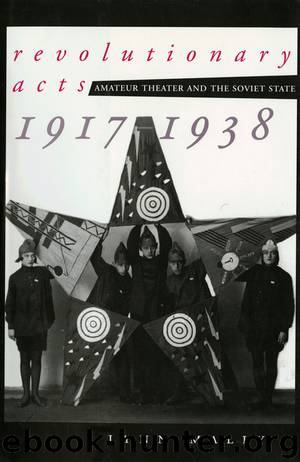REVOLUTIONARY ACTS by LYNN MALLY

Author:LYNN MALLY
Language: eng
Format: epub
Publisher: CORNELL UNIVERSITY PRESS
Published: 2016-05-26T16:00:00+00:00
The Vanguard of Amateur Art
TRAM achieved a national following during the early years of the First Five-Year Plan (1928–32), a period of rupture so extreme that Stalin called it the “Great Break.”77 As the state launched programs of breakneck industrialization and coerced collectivization, radical cultural projects were initiated at a feverish pace. City planners turned against the idea of cities; legal experts envisioned the withering away of law. These iconoclastic dreams had a profound effect on the broad array of amateur stages, which began to use cafeterias and dormitories as stages to enact disruptive social dramas (see chapter 5). For TRAM, this period of experimentation brought it even more public attention. Its own oxymoronic vision of a professional theater that disdained professionals fit the spirit of social leveling initiated by the plan.
As many scholars have argued, the First Five-Year Plan was to some degree a youth rebellion.78 Given the general privileging of youth, it should come as no surprise that TRAM—a theater by and for young people—would gain notoriety. Its political guardian, the Komsomol, won much greater visibility as an initiator of cultural campaigns. Not only did the Komsomol attack conventional educational programs, it also waged a war of words against the citadels of high culture. Both the Bol’shoi Theater and the Moscow Art Theater faced stinging attacks in the Komsomol press for their generous government funding, non-proletarian social composition, and outdated, anti-revolutionary repertoires. As the Komsomol assaulted these remnants of the old world, it championed new institutions like TRAM and attempted to win them greater financial support.79
The Leningrad TRAM’s shift to professional status gave it much more national visibility. With support from the Komsomol, the theater made its first tour to Moscow in the summer of 1928, which helped to popularize TRAM plays and methods. It took Call the Factory Committee, Happy Cohort, and a new play, The Days Are Melting (Plaviatsia dm), which examined the strains experienced by a young Komsomol couple when a child was born.80 The group was met by enthusiastic audiences everywhere it went: in Orekhovo-Zuevo, a textile town not far from Moscow, they had to add extra performances; in Moscow itself, nearly twenty-five thousand people showed up for TRAM productions.81 As the industrialization drive began in earnest, TRAM collectives spread throughout Soviet territory. Only a handful of TRAM circles existed outside of Leningrad before 1928 but some observers counted up to seventy by the end of the year and three hundred by 1932.82 The Leningrad TRAM and its repertoire inspired emulation across the nation, as new factory and city-based TRAM organizations took shape. The vast majority of these new theaters, spread from Baku to Magnitogorsk, were amateur circles.83
TRAM began to attract the attention of national cultural institutions. At the Conference on Artistic Work among Youth, which met in Moscow in the summer of 1928, Anatolii Lunacharskii, the head of Narkompros, called TRAM a model for building a new socialist theater.84 The following month, he praised TRAM’S work in the nation’s newspaper of record, Pravda.
Download
This site does not store any files on its server. We only index and link to content provided by other sites. Please contact the content providers to delete copyright contents if any and email us, we'll remove relevant links or contents immediately.
Aircraft Design of WWII: A Sketchbook by Lockheed Aircraft Corporation(32192)
The Great Music City by Andrea Baker(31252)
Call Me by Your Name by André Aciman(20352)
The Secret History by Donna Tartt(18813)
The Art of Boudoir Photography: How to Create Stunning Photographs of Women by Christa Meola(18506)
Shoot Sexy by Ryan Armbrust(17637)
Plagued by Fire by Paul Hendrickson(17315)
Portrait Mastery in Black & White: Learn the Signature Style of a Legendary Photographer by Tim Kelly(16934)
Adobe Camera Raw For Digital Photographers Only by Rob Sheppard(16882)
Photographically Speaking: A Deeper Look at Creating Stronger Images (Eva Spring's Library) by David duChemin(16601)
Ready Player One by Cline Ernest(14498)
Pimp by Iceberg Slim(14330)
Bombshells: Glamour Girls of a Lifetime by Sullivan Steve(13954)
The Goal (Off-Campus #4) by Elle Kennedy(13486)
Art Nude Photography Explained: How to Photograph and Understand Great Art Nude Images by Simon Walden(12954)
Kathy Andrews Collection by Kathy Andrews(11710)
The Priory of the Orange Tree by Samantha Shannon(8869)
The remains of the day by Kazuo Ishiguro(8793)
Thirteen Reasons Why by Jay Asher(8770)
